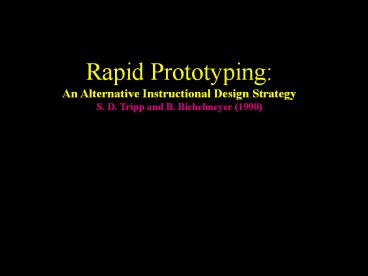Rapid Prototyping: An Alternative Instructional Design Strategy S. D. Tripp and B. Bichelmeyer (1990) PowerPoint PPT Presentation
Title: Rapid Prototyping: An Alternative Instructional Design Strategy S. D. Tripp and B. Bichelmeyer (1990)
1
Rapid PrototypingAn Alternative Instructional
Design StrategyS. D. Tripp and B. Bichelmeyer
(1990)
2
A Practical Discussion
- What is it?
- Why use it?
- Why does it work?
- What does it look like?
- What are the pitfalls?
- Why doesnt everyone use it?
3
Rapid PrototypingWhat Is It?
Rapid prototyping. In a design process, early
development of a small-scale prototype used to
test out certain key features of the design.
- Tripps Model of Rapid Prototyping
- Design methodology
- Applicable to instructional design for
computer-based instruction - Extend into a new domain
- Roots from engineering design
- scientific approach
- phased -state model
- Prototyping
- testing ideas
- mock-up
4
Classical approach to software development -- the
waterfall cycle
- concept definition
- requirements definition
- preliminary design
- detailed design
- code implementation
- test and acceptance
- griping
5
Rapid prototyping -- the spiral cycle
- concept definition
- implementation of a skeletal system
- user evaluation and concept refinement
- implementation of refined requirements
- user evaluation and concept refinement
- implementation of refined requirements
- etc., etc., in a continuous cycle.
6
What is it?
Determine Feasibility
Study Present System
Define Prototype
Build Prototype
Prototyping Approach to Software Design
Exercise Prototype
Convert
Install
Assess Needs and Analyze Content
Set Objectives
Construct Prototype (Design)
Utilize Prototype (Research)
Install and Maintain System
The Rapid Prototyping ISD Model
7
Why use it?
- Traditional Design
- extensive documentation but doesnt reduce
communication problems. - thorough, but doesnt please users.
- ID phases but doesnt decrease project time.
- tracks project cost but doesnt reduce them.
- describes system but doesnt guarantee its the
right system.
- Rapid Prototyping
- users can try out the system, discover problems,
provide input. - pleases users.
- reduces development time.
- reduces development costs.
- produces the right system for the designated
task.
8
Rapid Prototyping May Be Done
- 1. to test out a user interface
- 2. to test the database structure and flow of
information in a training system - 3. to test the effectiveness and appeal of a
particular instructional strategy - 4. to develop a model case or practice exercise
that can serve as a template for others - 5. to give clients and sponsors a more concrete
model of the intended instructional product - 6. to get user feedback and reactions to two
competing approaches.
9
Rapid Prototyping Why Does It Work?
- Requires the Appropriate Medium (Tools)
- computer software
- with modularity
- with plasticity
- Appropriate Medium Examples
- HyperCard
- PowerPoint
- HTML
- other object-oriented computer programs
10
An example of rapid prototyping
- First pass
- http//www.umich.edu/aaps/OLDoz
- A lot of text, kids don't want to read this much
text off of a computer screen - Second attempt
- http//www.umich.edu/aaps/disaster/dszt_wel.htm
- More graphics in this one.
- Third generation
- http//www.umich.edu/aaps/mygeology/
- This version goes to an opening imagemap, rather
than text.
11
First version
12
Second version
13
Third version
14
Different views about RP
- Rapid prototyping should include all the required
database, the major program modules, screen
displays, and inputs and outputs for the
interacting systems. (Tripp, Bichelmeyer) - Tessmer (1994) also considers rapid prototyping
to be a working part of the final product, - Jones, Li, and Merrill (1992) say that rapid
prototyping is essentially a feasible version of
the final product.
15
Different views about RP
- On the other hand, Dorsey, Goodrum, and Schwen
(1995) define rapid prototyping as a graphic
cartoon of the possible solutions that will be
incorporated into the basic functional
components, - Boling and Frick (1998) use the term rapid
holistic prototype because the prototyping will
be rapid but not include everything that the
final version will contain. Hence, Dorsey,
Goodrum, and Schwen (1995), as well as Boling and
Frick (1988), emphasize the earlier versions of
prototyping rather than other researchers.
16
Rapid PrototypingWhat Are the Pitfalls?
- Can lead to a design-by-repair philosophy.
- Does not eliminate front-end analysis.
- Cannot substitute for a paper analysis.
- Some ISD principles may not be addressed.
- May lead to premature commitment.
- Creeping featurism may lead to designs that are
out of control!
17
Rapid PrototypingWhy Doesnt Everyone Use It?
- Rapid prototyping methodology represents a
paradigmatic shift in understanding the nature
and purpose of the field of instructional design.
18
Similarities and Differences of Formative
Evaluation and RP
19
Contrast Between RP and Traditional ID on
Selected Factors
20
Project Step one
- Find the topic
- Analysis (Submit a report)
- needs, analysis
- learner analysis
- content/task analysis
- statement of the general goal
- Pedagogical approach and justification for the
approach - You have 2 weeks to finish the analysis
21
(No Transcript)
22
Thank you for attending this presentation

